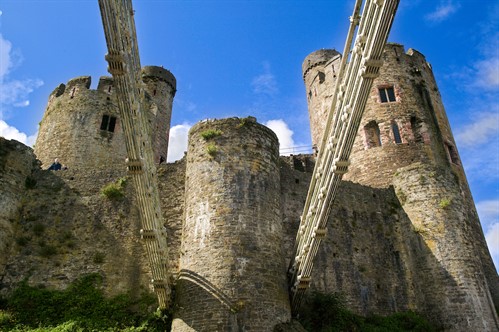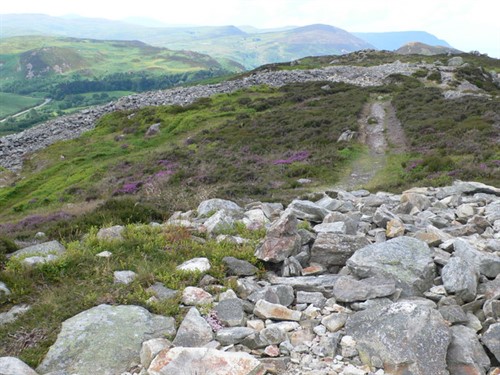Posted on 08/02/2017 by David
The historic walled town of Conwy draws in the crowds year after year. The architectural excellence of the castle and the presence of intact and largely unaltered walls are a big part of the town’s appeal, making it a unique and interesting experience for visitors from across the globe.
However…...
There is so much more to Conwy and the surrounding area than the castle and town walls (as impressive as they are).
Perhaps you’re a returning visitor and would like to see Conwy from a new perspective, or just want to escape the crowds and enjoy some alternative attractions to those that the guidebooks have to offer.
Here we look at some of the best kept secrets of Conwy. This combination of local knowledge, myths, legends and fascinating natural history will give you a completely new Conwy experience.

Secrets within the walls
Well first off, The Black Lion (11 Castle Street) has to get a mention. This iconic building is the second oldest in Conwy.
Though it is often referenced as being constructed in 1589, timber from it’s trusses have been found to date back to 1441-42. The house occasionally gets a brief mention in tourist guides, but there is plenty more to be uncovered in the history of this building, with it’s secret tunnels and trapdoors - you can only imagine the goings on in this building over the centuries!
Look out for the metal jackdaw statues on the roof. A nod to the auspicious Jackdaw Society, which was open only to those born within the town walls.
The church on the mountain - Llangelynin Church and Holy Well
Pull on your hiking boots, pack up some lunch and head out for a walk in the rolling hills above Conwy.
There is just so much to find up on the hillside - and this hidden church won’t disappoint. This remote 12th century church is nestled below the distinctive ridge of Tal y Fan (affectionately known as Conwy Mountain by locals).
If you find it, take a moment to imagine making the ascent up the mountain in the blistering cold wind and rain to worship - it’s quite remarkable!
See if you can find the holy well of St Celynin, famed for its power to cure sick children. The well sits within a small stone enclosure in the corner of the churchyard. Look carefully - in summer it gets hidden beneath the overgrowth.
You can also find the footings of an ancient inn nearby, which would have provided shelter for those travelling across the mountain from the Conwy Valley to Penmaenmawr and beyond.
The 10 mile walk from Conwy to Llangelynin takes around 4 hours and can be quite steep in places, but the views across Conwy county and beyond are astounding.

An unexpected history - Pensychnant
The history of the upland above Conwy is captivating. Conwy Mountain has Bronze Age burial sites, an Iron Age fortress called Caer Seion, and the remains of medieval feudal field systems…. if you know where to look!
But, if you want a history lesson like no other - take a trip up to Pensychnant.
Expect to leave with a whole host of unexpected facts and a totally new view on what makes Conwy and the surrounding landscape so special. Julian at Pensychnant Conservation Centre will immerse you into a detailed and enthralling tale of the land. Take a tour and learn all about Conwy’s geology, natural history and bronze age trade and industry
All that aside - the house at Pensychnant is itself is a hidden gem. It was originally built in 1690, though the house as it is now reflects the architectural character of the Victorian era. A walk around the estate offers visitors a snapshot of life for the Stott family whose fortune was made (and lost) in the Manchester cotton mills.
Tales from across the water
The village of Glan Conwy is easily overlooked, but has a history all of it’s own - not to mention an incredible view of Conwy Castle and the estuary.
Glan Conwy is thought to have been a settlement for at least 1500 years. In the Georgian era it was a busy port, where ships would carry flour from the mill, fruit from the farms, timber, slates and even iron from the furnace at Bodnant to Chester and Bristol.
At one time it was a thriving shipbuilding village, some of those built travelled as far as Australia - though the estuary’s fast tidal currents were notoriously dangerous and many ships sank here. Some wrecks can still be seen in the mudflats at low tide.
Want an exclusive view of Conwy? Bryn Eisteddfod Gardens very occasionally (hint - usually the last bank holiday in May - but check with the owner first!) opens to the public. Proud owner (and utterly fascinating character) Dr Michael Senior has nurtured the eight acres of landscaped grounds for over 50 years.
The 18th-century formal gardens comprise a mature shrubbery, arboretum, an old walled Dutch garden and expansive lawn with picture perfect views over the Conwy Valley.
'The most impressive thing called Conwy is the town itself.'
I shall leave you with that statement to ponder, and if you do visit any of these wonderful places, we'd love to hear what you think.
Conwy Castle images: © Crown copyright 2016 (Visit Wales)
Caer Seion: courtesy of Eirian Evans, via Creative Commons.

